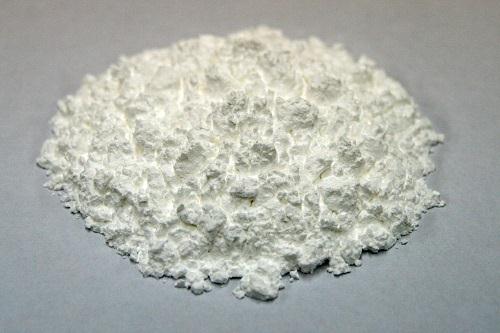| Identification | More | [Name]
Yttrium oxide | [CAS]
1314-36-9 | [Synonyms]
Y203 A
Y203 AT
Y203 B
Y203 C
YTTRIA
YTTRIUM(+3)OXIDE
YTTRIUM(III) OXIDE
YTTRIUM OXIDE
diyttriumtrioxide
yo3-245
yttriumoxide(y2o3)
yttriumsesquioxide
yttriumtrioxide
YttriumoxideREO
7Yttrium oxide
Yttrium(III) oxide pellets
YTTRIUM OXIDE, NANOPOWDER, <50NM
YTTRIUM(III) OXIDE, NANOPARTICLES, <50NM (BET), 99.9+%, 5 WT. % DISPERSION IN WATER
YTTRIUM(III) OXIDE, 99.99%
YTTRIUM(III) OXIDE, 99.999% | [EINECS(EC#)]
215-233-5 | [Molecular Formula]
O3Y2 | [MDL Number]
MFCD00011473 | [Molecular Weight]
225.81 | [MOL File]
1314-36-9.mol |
| Chemical Properties | Back Directory | [Appearance]
white powder | [Melting point ]
2410 °C
| [Boiling point ]
81-83 °C | [density ]
5.01 g/mL at 25 °C(lit.)
| [Fp ]
12 °C | [storage temp. ]
Storage temperature: no restrictions. | [solubility ]
soluble in dilute acid solutions | [form ]
nanopowder
| [color ]
White | [Specific Gravity]
5.01 | [PH]
10±1 | [Water Solubility ]
Insoluble | [Crystal Structure]
Trigonal | [Sensitive ]
Air Sensitive | [crystal system]
Cube | [Merck ]
14,10107 | [Space group]
Ia3 | [Lattice constant]
| a/nm | b/nm | c/nm | α/o | β/o | γ/o | V/nm3 | | 1.06 | 1.06 | 1.06 | 90 | 90 | 90 | 1.191 |
| [Exposure limits]
ACGIH: TWA 1 mg/m3
NIOSH: IDLH 500 mg/m3; TWA 1 mg/m3 | [InChIKey]
SIWVEOZUMHYXCS-UHFFFAOYSA-N | [CAS DataBase Reference]
1314-36-9(CAS DataBase Reference) | [EPA Substance Registry System]
1314-36-9(EPA Substance) |
| Hazard Information | Back Directory | [Chemical Properties]
white powder(s) or sintered tablets and pieces of 99.9% purity; bcc; readily absorbs atmospheric CO2; enthalpy of fusion 105.00 kJ/mol; used in crucible form for experimental, proprietary melting, also sintered pieces used as evaporation material for hard film dielectric coating and thin film capacitors, and as 99.999%, 99.99%, 99.9% pure sputtering target for preparing hard films, dielectric coatings, and thin film capacitor [CER91] [MER06] [CRC10] | [General Description]
Yttrium oxide is an excellent mineralizing agent for spinel formation. It has a high melting point(2450oC), chemical stability, low coefficient of thermal expansion, high transparency for both visible (70%) and infrared (60%) light, low cut off energy of photons. | [Flammability and Explosibility]
Nonflammable | [reaction suitability]
core: yttrium |
| Safety Data | Back Directory | [Hazard Codes ]
Xi,F | [Risk Statements ]
R36/37/38:Irritating to eyes, respiratory system and skin .
R67:Vapors may cause drowsiness and dizziness.
R36/37:Irritating to eyes and respiratory system . | [Safety Statements ]
S26:In case of contact with eyes, rinse immediately with plenty of water and seek medical advice .
S36:Wear suitable protective clothing .
S37/39:Wear suitable gloves and eye/face protection . | [RIDADR ]
UN1950 | [WGK Germany ]
1
| [RTECS ]
ZG3850000
| [F ]
3-9 | [TSCA ]
Yes | [HazardClass ]
2.1 | [HS Code ]
28469011 | [Safety Profile]
A poison by intraperitoneal route. See also
YTTRIUM and RARE EARTHS. | [Toxicity]
mouse,LD50,intraperitoneal,430mg/kg (430mg/kg),"Toxicometric Parameters of Industrial Toxic Chemicals Under Single Exposure," Izmerov, N.F., et al., Moscow, Centre of International Projects, GKNT, 1982Vol. -, Pg. 121, 1982. |
| Questions And Answer | Back Directory | [Physical Properties]
White powder; body-centered cubic structure; density 5.03 g/cm3; melts at 2,436°C; insoluble in water; soluble in dilute acids.
 | [Uses]
Yttrium Oxide, also called Yttria, high purity Yttrium Oxides are the most important materials for tri-bands Rare Earth phosphors which give the red colour in colour television & computer tubes. In optical industry, the Yttrium Oxide is used to produce Yttrium-Iron-Garnets, which are very effective microwave filters. Low purity of Yttrium Oxide are widely applied in electronic ceramics. It is widely used to make Eu:YVO4 and Eu:Y2O3 phosphors that give the red color in color TV picture tubes.
Also, it is used in gas mantles and acetylene lights. Other uses are in yttriumiron garnets for microwave filters in lasers, and as a stabilizer for high temperature in refractories.
| [Preparation]
Yttrium oxide is produced as an intermediate in recovery of yttrium from xenotime and monazite (See Yttrium, Recovery). The oxide is produced after separation of rare earth sulfates obtained from digesting the mineral with sulfuric acid on a cation exchange bed, precipitating yttrium fraction as oxalate, and igniting the oxalate at 750°C.
Yttrium oxide also may be obtained by thermal decomposition of yttrium nitrate.
|
| Questions and Answers (Q&A) | Back Directory | [References]
Industry
Application
Role/benefit
Gas lighting
Manufacture of gas mantles
Effective component/has extremely high temperature stability
Inorganic synthesis
Manufacture of Yttrium compounds
Raw material/source of Yttrium
Ceramic
Manufacture of pure ceramic
Raw material or additive/has extremely high temperature stability and outstanding resistance to alkaline melts
Manufacture of other ceramic material (Si3N4, AlN, ZrO2, etc.)
Multilayer ceramic capacitors
Display materials
Color TV picture tubes
Additive material/used as raw material to make Eu:YVO4 and Eu:Y2O3 phosphors that give the red color
Insulator
Insulator coating
Effective component/extremely thermodynamically stable and resistant to many reactive molten metals
Nuclear technology
Coating material for graphite in nuclear technology
Main component/extremely thermodynamically stable
Diluting uranium oxide for nuclear fuel rods
Diluting agent/ Yttrium oxide can form a solid solution with uranium oxide
Refractory
Coating material for high-temperature applications
Main component/extremely thermodynamically stable
Others
Manufacture of steel, non-ferrous alloys and iron
Additive/extremely thermodynamically stable
Manufacture of IR and UV translucent glass
Manufacture of high-temperature superconductors
Preparation of permanent magnets
Additive
Prospective solid-state laser material
Dopant / lasers with ytterbium allow the efficient operation both in continuous operation and in pulsed regimes
Making Yttrium iron garnets for powerful microwave filters
Raw material/source of Yttrium
Ultrafast sensors used in g-ray and x-rays
Additive
Paints and plastics
Additive/decreases UV degradation
| [References]
1.https://en.wikipedia.org/wiki/Yttrium(III)_oxide#Use
2.https://www.hcstarck.com/en/products/advanced_ceramics/yttrium_oxide.html
3.https://www.azonano.com/article.aspx?ArticleID=3345
4.http://www.samaterials.com/content/177-what-is-yttrium-oxide-used-for
5.http://www.us-nano.com/inc/sdetail/10054
6.http://www.horiba.com/fileadmin/uploads/Scientific/Documents/PSA/Application_Notes/AN33_Yttrium_oxide.pdf
7.http://www.is0513.com/ProductChemicalPropertiesCB2780546.htm
|
|
|